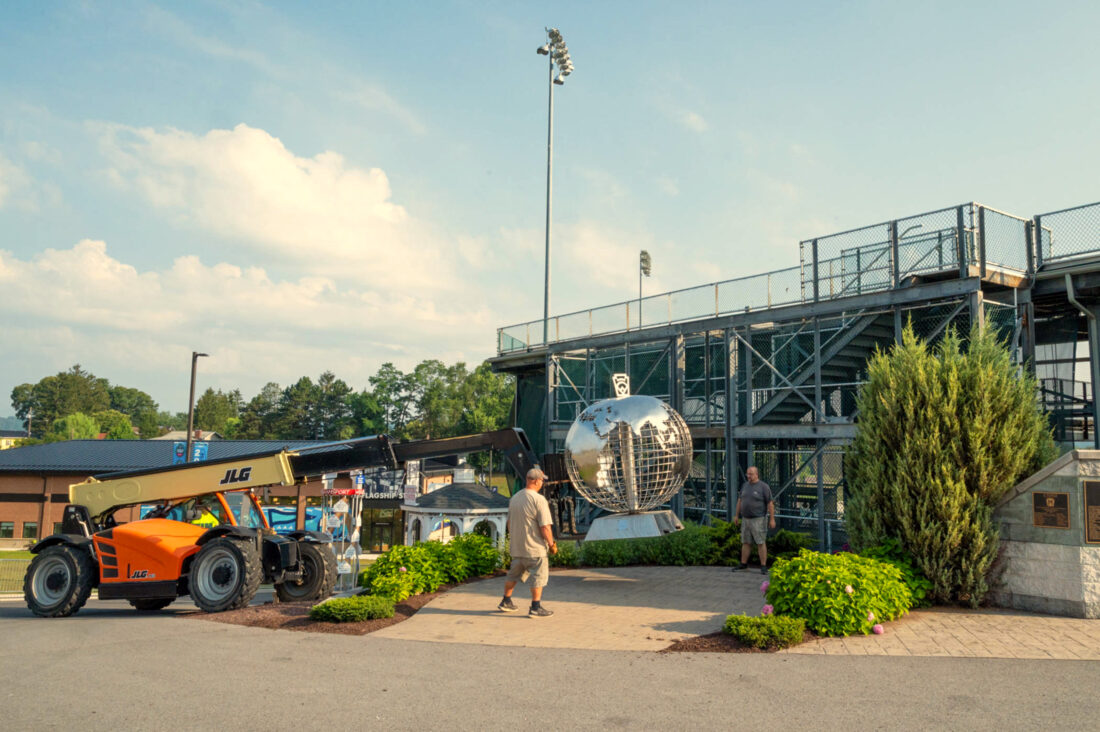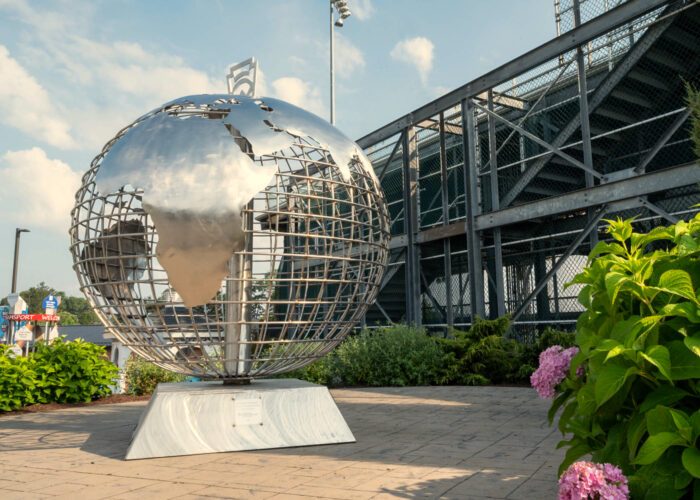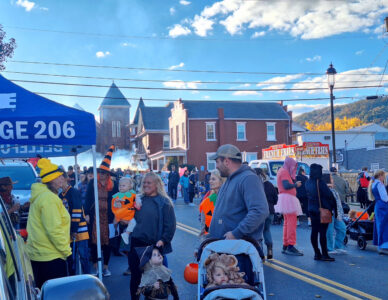Penn College students fabricate steel globe for Little League

PHOTO PROVIDED The 1,200-pound stainless steel globe structure, fabricated by Pennsylvania College of Technology students and faculty, is lowered into place outside of Volunteer Stadium on Little League’s complex in South Williamsport.

PHOTO PROVIDED
Pennsylvania College of Technology students and faculty spent the Spring 2025 semester fabricating the 7-foot-tall stainless steel globe for placement near Little League’s Volunteer Stadium. More than 70 students worked on the structure, which required about 1,000 feet of round stock. The globe is envisioned as a prime photo opportunity for the tens of thousands of fans who attend the Little League World Series.
WILLIAMSPORT — Pennsylvania College of Technology welding students are the spark behind an eye-catching addition to the Little League Baseball World Series complex in South Williamsport: a roughly 7-foot-tall stainless steel globe structure featuring metal cutouts shaped to represent the continents.
“It’s not every day that you get to build a globe, especially using round stock and stainless steel,” said Michael R. Allen, instructor and co-department head of welding. “This is probably one of the most unique projects we’ve done. It makes me feel good that our students did it for the public.”
More than 70 students in five sections of Allen’s Welding Blueprint & Layout II class used about 1,000 feet of round stock throughout the Spring 2025 semester to fabricate the globe, an idea hatched from a brainstorming session among Little League International staff two years ago.
The globe is envisioned as a prime photo opportunity for the roughly 300,000 fans who attend the World Series each August. It also showcases Little League’s global impact while holding true to the community where the program was born. For this year’s event (Aug. 13-24), the structure will be located outside of Volunteer Stadium on the main concourse.
“Little League International has such a great relationship with Penn College. We just naturally thought that Penn College could be a resource,” said Brian McClintock, senior communications executive at Little League. “They’re known for their manufacturing, their welding, their engineering. The globe is incredible. I think it will be a great installation for years to come.”
Danielle Gannon, a graphic designer at Little League — with support from fellow graphic designer Natalie Lincalis and creative director Amanda Cropper-Rose — developed the concept drawings for the globe. All three are Penn College graduates.
The Little League sketches served as a model for Penn College’s Craig A. Miller. The assistant professor and department head of engineering design technology used the drawings to devise blueprints for Allen and his welding students to follow in fabricating the globe.
“When I saw the blueprints, I was like, ‘OK, this is going to be a handful,'” recalled Clayton J. Fegley, a welding & fabrication engineering technology student from McClure. “But as the project went on, it definitely got more manageable. I was just excited to have a hand in this project knowing that it’s going to be seen by so many.”
“I was honestly shocked. I didn’t think it was doable,” added classmate Alaina S. Myers, of Hanover. “I had never worked on a project like this. I was intrigued and super excited to get my hands on it. I had no idea what to expect.”
Neither did Allen. That’s why he instructed some students to construct a mockup of the globe out of mild steel. About half the size of the eventual 6-foot-diameter sculpture, the prototype prompted a vital decision.
“We found that if we set the globe up vertically that we could not reach the top of it,” Allen explained. “So, we decided to build a fixture to lay the globe sideways so we could actually spin it and roll it. That way, it would be a lot easier to reach the top and the bottom to weld things together.”
While one group of students fabricated the “practice globe,” another contingent began working on the real thing. They welded the base out of three sheets of 3/8-inch stainless steel, leaving pockets so the eventual 1,200-pound structure could be moved by forklift. During the initial stage, a couple students also employed a CNC plasma cutter to produce the globe’s stand. Allen later used the same machine to cut out the continents, as well as Little League’s keystone emblem for placement on top of the globe.
That work in the college’s 55,000-plus-square-foot welding facility was easy compared to the painstaking tasks to come.
Students spent weeks operating an angle roller to bend the round stock into precise circles that would form the structural framework of the globe. The first set of circular rods were aligned and welded to 18-inch-diamater stainless steel plates at the top and bottom of the globe. The remaining rods were positioned horizontally to complete the globe’s spherical form.
“I would say the most challenging part was keeping the rods spaced properly,” Allen said. “The prints told us what the spacing was supposed to be. We cut out aluminum spacers on the CNC and used them to separate the rods.”
The welding process presented another dilemma.
“When you start to weld stainless and it heats up, it warps a little bit,” Allen said. “The rods were moving, so we had to clamp things back to hold everything in place so that the rods wouldn’t move that much. The spacing isn’t perfect, but it’s as close as we could get it with everything that we were doing.”
Multiple sections of students working on the globe added to the project’s complexity, according to Fegley. “It was tough coming in and not knowing what the previous class did, how well it went or if something went wrong,” he said. “So, it was kind of hard picking up where they left off.”
Myers agreed. “It was hard to communicate between the classes, but that’s what made it interesting,” she said. “It was fun to see what others achieved and what we could build on to finish this thing.”
The welding students finished their part of the project in April.
“Overall, I would say they did really well with this,” Allen said. “They showed professionalism doing it. They were thinking ahead about how to do things. They weren’t just standing there waiting for me to tell them how to do it. They actually put the time in and came up with ideas. I encouraged them to do that.”
Students in a sheet metal forming and fabrication course were the next group assigned to the globe. The class intended to use an English wheel to manually shape the continents so they could be added to the structure. However, after a week of experimentation, it was determined that the English wheel couldn’t adequately curve the continents, which were made from 20-gauge stainless steel.
Instructor Roy H. Klinger, who leads the college’s automotive restoration program, stepped up to complete the project.
“Sheet metal forming predominantly falls in vintage car restoration and/or prototyping areas of the automotive industry,” Klinger said. “The material requires an extreme amount of force to do the actual shaping process.”
Over several days, Klinger applied such force to the metal continents with a power hammer so the cutouts could be shaped to fit the contour of the globe. “It seems rather rudimentary and basic; however, it takes advanced-level skills to be able to move that particular material into the desired shape,” he said.
Daniel J. Ravizza, instructor of CNC machining and automation, and Klinger relied on a spot welder to attach the continents to the globe. The duo completed the project by polishing the continents with drum-sanding units.
“Our students and faculty did an amazing job rising to the challenge of fabricating the globe to be enjoyed by countless Little League fans long into the future,” said Bradley M. Webb, dean of engineering technologies. “The ingenuity and craftsmanship they demonstrated are a testament to the college’s commitment to applied technology education. What other college can say that its students and faculty built a globe for a world-renowned organization such as Little League?”
The unique opportunity isn’t lost on the students.
“I’m beyond grateful that we got to partner with Little League and make this awesome project with them,” Fegley said.
“It’s going to be awesome to come back in years to see it with family and friends and say, ‘I had a hand in that,'” Myers said with a smile. “It was a great experience.”
For information on manufacturing-related degrees and other majors offered by Penn College’s School of Engineering Technologies, visit www.pct.edu/et or call 570-327-4520.
Penn College is a national leader in applied technology education. Visit www.pct.edu, email admissions@pct.edu or call toll-free 800-367-9222.


